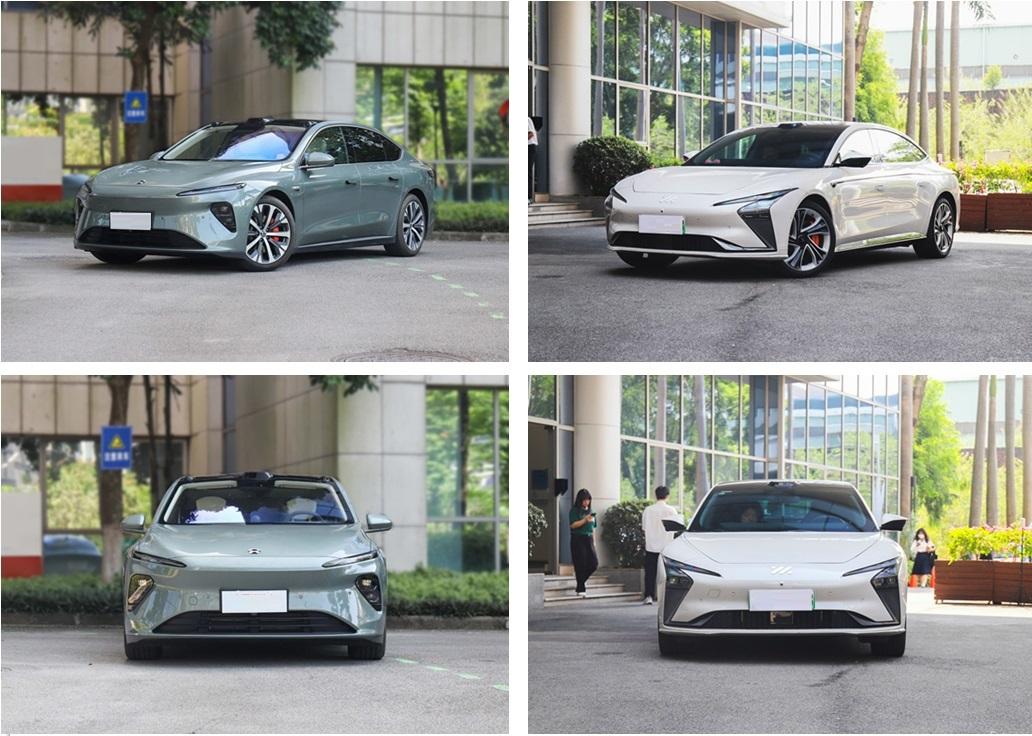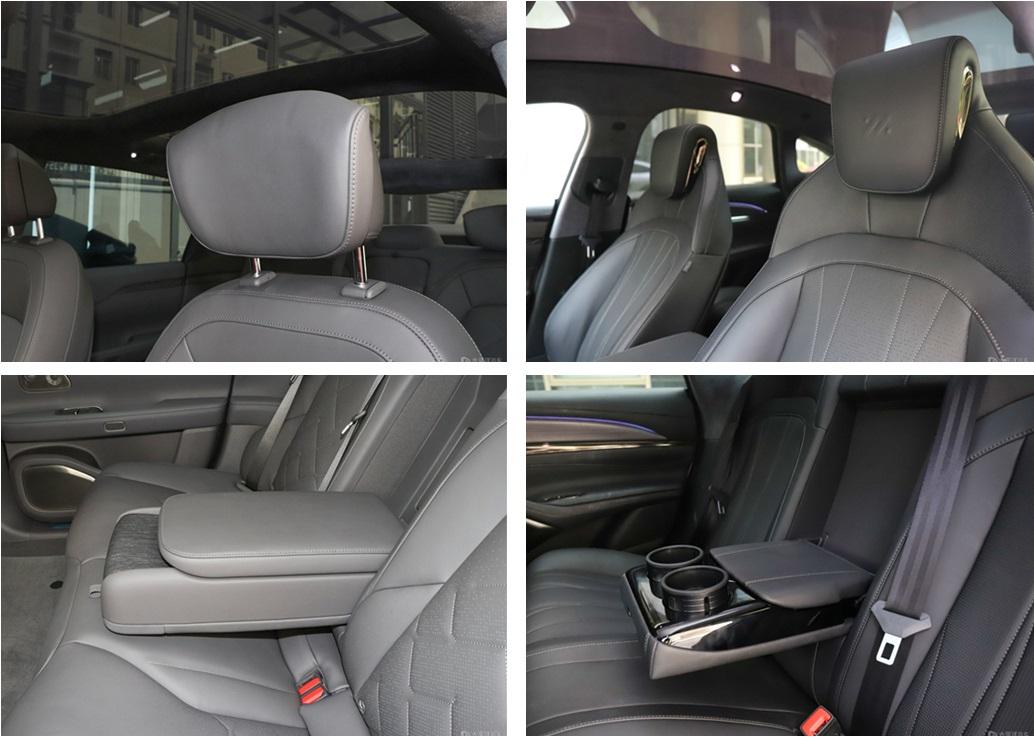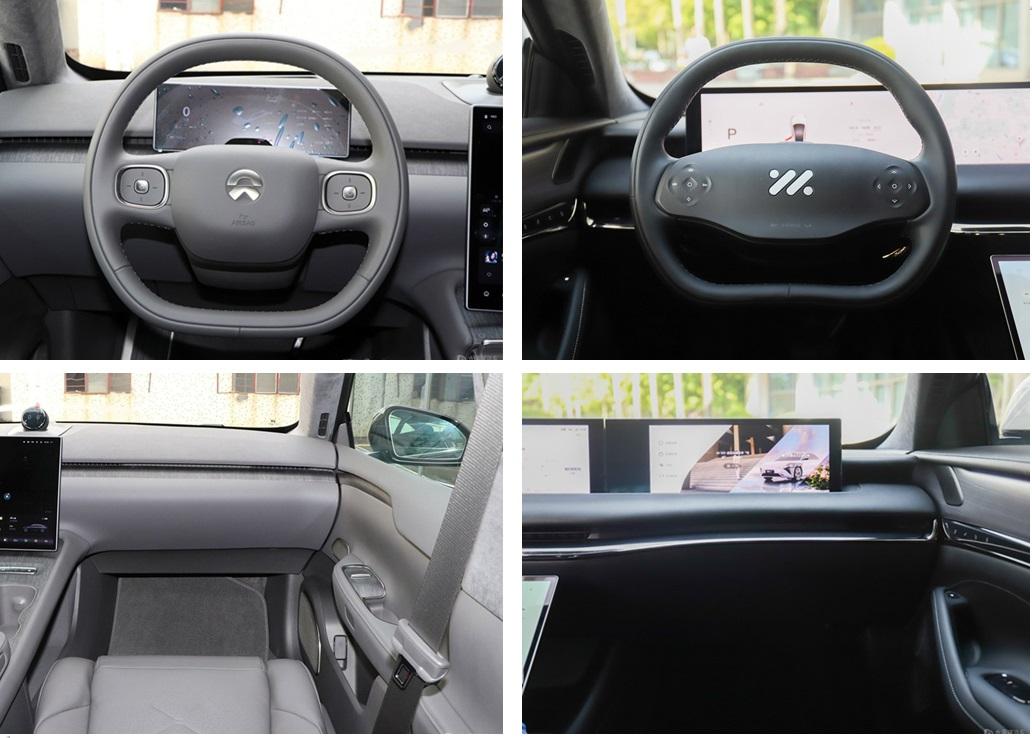In the past two years, as the electrification of automobiles continues, domestic new energy vehicles have seen a comprehensive development. They have launched many high-quality models. The first production model of IM L7, which relies on SAIC Group, is located in a mid-size car with a manufacturer's guide price of 368,800-578,800 yuan, benchmarking against popular models such as ZEEKR 001 and NIO ET7. So who is the cost-effective choice between the ET7 and the L7, both of which are mid- to high-end domestic new energy sedans? Let's analyze the differences between them in terms of design, performance and technological intelligence.
Exterior& Interior: Both have a sense of technology and sportiness

1、Appearance
Both models use the latest family design language, the overall shape is relatively rounded and simple without losing the sense of technology. The front part of the car adopts the typical closed shape of a pure electric car, but the ET7 is more simple and clear, while the "X" design of the L7 is more aggressive. Both models have a distinctive lighting design: the ET7 has a split design with a distinctive brand identity, while the L7 has recognizable "∑" LED daytime running lights, and the internal structure of the intelligent headlights has a layered design and can display different light languages. The bottom of both cars are equipped with an active opening and closing lower grille with a smoked black finish, the difference being that the ET7 has a horizontal design while the L7 has a vertical design.
The body part, both adopt the more mainstream coupe design, the downward pressure of the front end with the sliding roof design, showing a good swoop effect. Both cars adopt the mainstream "double waistline" design, with a slightly upward lower waistline combined with recessed doors, making the whole side of the car look more rhythmic, while the upper waistline of the IM L7 extends from the front fender to the taillight cluster, looking more narrow. The wheels are both 20-inch sports wheels, and the front wheels are equipped with Brembo's four-piston brake calipers, both with excellent braking effect. In addition, the two cars have silver-rimmed decorative window frames, bezel-less doors, rear privacy glass, low wind resistance mirrors, hidden door handles and other designs are also very technological.
The upper half of the car has the mainstream tail lights and duck tail design, but compared to the ET7, which is not decorated with too many elements, the ET7 looks more stable, while the L7, with its narrow and sharp design, looks more aggressive and sporty. The lower part of the car is more different. The ET7 with a lot of straight lines has a more layered look, while the L7 with a split design enhances the vehicle's refinement and adds a sporty attribute to the rear of the car.
- Interior
The interiors of both models show a trendy design style, simple and stylish without losing the sense of technology. The air conditioning vents are of a through design, with the ET7 having a better overall appearance and the L7 having a stronger sense of hierarchy. The functional areas are all without physical buttons, looking relatively simple and tidy. In the hardware part of the technology configuration, NIO ET7 still sticks to the family style and does not follow the trend of multi-screen and joint-screen, while IM L7 adopts a large through-screen design, with a joint-screen size of 39 inches, and can be lifted independently, compared to IM L7, which has a stronger sense of technology.
The center console is covered with a large area of soft material and incorporates wood grain trim and stitching to enhance the interior. The rattan wood trim on the ET7 has a unique texture, while the solid wood trim on the L7 is also very textured. The steering wheel has a retro double-spoke flat-bottom design and is wrapped in two-tone leather, which is delicate to the touch, but the NIO ET7 has a fuller grip. The steering wheel is flanked by touch function keys, with a simple button layout and a delicate logo in the center. The steering wheel is also functional and supports electric adjustment, and is equipped with multi-function control, memory function and heating function as standard.
- Space
In terms of body size, both models are located in medium to large size cars. The length, width and height of the ET7 are 5101mm, 1987mm and 1509mm respectively, with a wheelbase of 3060mm. The width and height of the ET7 are superior, while the wheelbase of the L7 is also longer. In terms of ride space, both models have a "2+3" five-seat layout, with ample space in the front row. 176cm people can sit in the front seats, and after adjusting to a comfortable position, there is about one fist and one finger of head space left. The rear space is also in line with the level of this class, but the NIO ET7, with its superior height, still has a fist and two fingers of headroom left, while the L7, with its superior wheelbase, has a fist and four fingers of legroom left. In the luggage compartment, they all have large openings and good depths, so it's easy to access items.
4、Ride experience
Both models have leather seats (Nappa leather seats are available as an option), the front seats are wide and comfortable, the cushion support and the wrapping of the backrest wings on both sides are excellent, the rear seats are also comfortable to the mainstream level, the softness and hardness of the seats on both sides are moderate, but the padding of the middle seats is slightly thin, and they are not equipped with headrests, so the comfort is slightly worse than the two sides, the NIO ET7's The middle cushion of the ET7 is also a bit short, so for passengers with long legs, the support may not be sufficient. The front seats are electrically adjustable and equipped with heating, ventilation, memory and massage functions, while the rear seats are also equipped with heating functions, although the ET7 is better equipped with ventilation and massage functions. It is also worth mentioning that the ET7 is equipped with double-layer soundproof glass, 180+ odor purification level, fragrance system and 22-speaker audio system to further enhance the driving experience.

NIO ET7 and IM L7 as mid-size electric cars with dual motors
1、Power
Both models are equipped with dual front and rear motors, and the front motor is a permanent magnet synchronous motor, while the rear motor type is slightly different, with the NIO ET7 using a relatively low-cost AC asynchronous motor and the IM L7 using a permanent magnet synchronous motor. In terms of performance parameters, the NIO ET7 has a total electric motor power of 480kW (653hp), front and rear motors with a maximum power of 180kW and 300kW respectively, and a total torque of 850N-m. The ZHI L7 has a total electric motor power of 425kW (578hp), front and rear motors with a maximum power of 175kW and 250kW respectively, and a total torque of 725N-m. Both cars have strong acceleration capabilities, with official 100km acceleration times below 4 seconds. In addition, both cars are equipped with pure electric intelligent four-wheel drive system, the control device can adjust the torque distribution of the front and rear motors according to the external road conditions, compared with the traditional four-wheel drive system, they are more flexible.
- Battery and range
The battery is made of lithium iron phosphate and lithium ternary batteries in the entry-level model of the ET7 and lithium ternary batteries in the L7. The battery temperature management system supports liquid cooling and low-temperature heating, and both are equipped with a fast-charging interface, but the L7 also comes standard with a charging pile for more convenient charging. The battery capacity of the ET7 is 75kWh, with a consumption of 16.2kWh/100km, while the L7 has a capacity of 93kWh, with a consumption of 15.4kWh/100km. This reduces wind resistance and the vehicle's center of gravity, and also improves the energy density of the battery pack. It is worth mentioning that both models are equipped with a brake energy recovery system and a pure electric modular design, and the entire vehicle structure has been optimized in terms of force paths to save electricity and improve safety.
3, chassis and tuning
The front suspension is slightly different from the rear suspension, with the NIO ET7 using the more comfortable multi-link independent suspension and the L7 using the more sporty double-wishbone independent suspension. The chassis tuning is more comfortable for the ET7 and more sporty for the L7. Both cars have a lightweight all-aluminum chassis with variable suspension, and the ET7 is equipped with air suspension, which is more high-end than traditional mechanical suspension, while the L7 is also equipped with CDC continuous damping control system, and the Williams Foresight Engineering team was selected to provide in-depth tuning of the chassis.
Test drive experience, the actual driving experience of the two models are relatively good, providing sports, energy saving and comfort modes, there are more obvious differences between the different driving modes, such as the steering wheel steering strength, the response of the electric door and the brake pedal foot feedback. Comfort mode, their steering wheel is relatively light, pointing is also very accurate, and the power output is more linear, low-speed driving is extremely easy, high-speed driving or rapid cornering, can also feel the chassis "toughness", fine vibration can be very good suppression, and encounter a large undulating potholes, the vehicle will not appear When encountering large potholes, the vehicle does not show a more obvious up and down bounce. In addition, the supercar mode of the L7 is also worth a try. After a key switch, the acceleration, braking and CDC response speed are all improved, and the smart scene screen switches to a half-screen immersion driving state and displays speed light effects, as well as simulated supercar sound and ambient lighting with linkage.

Is the car's Intelligent configuration cost-effective?
- Intelligent connectivity
The hardware part, NIO ET7 is equipped with a 10.2-inch full LCD instrument panel and a 12.8-inch suspended center control screen. The center control screen has a vertical design with good overall aesthetics, the UI interface layout is more traditional, the toolbar is located at the bottom of the screen, which is relatively simple to operate, the touch of the screen is delicate, and the bezel is not very large. The L7 is equipped with a 26.3-inch main driver screen, a 12.3-inch passenger screen and a 12.8-inch center screen. The main driver screen and the passenger screen have the same height and a better overall feeling, and they can be combined into a 39-inch shared screen, and can be decoupled according to the needs of the scene to meet the personalized experience of the main and passenger.
The UI layout of the L7 is simple and fresh, with a dark theme and light fonts, the overall contrast is comfortable, the screen feels smooth and flexible, and the touch response speed is not bad. In terms of screen resolution, both cars have mainstream performance. The dashboard and center screen of the ET7 have resolutions of 1920x532 pixels and 1728x1888 pixels respectively, while the main driver screen, passenger screen and center screen of the L7 have resolutions of 4320x720 pixels, 1920x720 pixels and 1728x1888 pixels respectively. The center screen is made of AMOLED material, which has a more delicate touch.
The software part of the two models also performs well. In addition to supporting regular functions such as intelligent voice, multimedia audio and video, in-car online services and vehicle control, they also support full-scene voice, semantic interruption, continuous dialogue and visible speak. The Banyan system on the ET7 also supports fragrance control, driving recorder control, driving mode and sound field mode, etc. In addition, it can also change the expressions on the screen according to the conversation scenario. In terms of vehicle control, the mobile app of NIO ET7 supports door control, digital key, vehicle start, charging management, air conditioning control, vehicle condition inquiry/diagnosis and vehicle location/tracking service, while the mobile app of IM L7 is even more feature-rich and supports lamp control, seat heating, steering wheel heating, maintenance/repair appointment and many personalized owner services.
2、Assisted driving
The NAD assisted driving system on the ET7 and the IM AD evolvable driving assistance system on the L7 can both reach the L2 level, but there are still some differences in their hardware. The ET7 is equipped with 11 exterior cameras, 1 interior camera, 12 ultrasonic radar, 5 millimeter wave radar and 1 laser radar, while the L7 is equipped with 12 exterior cameras, 2 interior cameras, 12 ultrasonic radar, 5 millimeter wave radar and 2 laser radar(optional). In comparison, the two models are equipped with sensing hardware that is close to each other, and both have the mainstream upper level.
In terms of assisted driving features, both models are well-equipped, such as brake-force distribution, brake assist, traction control, body stability system, lane departure warning, forward collision warning, lane keeping assist system, road traffic sign recognition, front and rear parking radar, 360° panoramic view, full-speed adaptive cruise control, automatic parking and uphill assistance, and other common configurations. There are also high-end and practical auxiliary features such as rear collision warning, reverse vehicle side warning, DOW door opening warning, active braking, lane assist, lane centering, active DMS fatigue detection, transparent image, automatic lane change assist, automatic ramp exit (entry) and automatic parking into the parking space. Other features, the two cars are also equipped with built-in high precision map, built-in car recorder, wireless charging and OTA upgrade for cell phones, and also optional remote summoning function.
Summary
The ET7 and L7 are both mid-size electric sedans with excellent product performance and precise control of consumer needs. Of course, there are some differences between the two models in terms of product design, performance and technological intelligence. The ET7 is more diversified, with a more trendy exterior and interior design, better power performance and seat comfort, and a slight advantage in brand recognition. However, the SAIC L7 is a late entry, but it has a full integration of resources, a more aggressive interior design, a large multi-link screen with a sense of technology, and excellent control and range. Finally, combined with the overall product power performance of the two models, which one will you like better?







